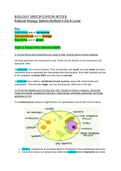BIOLOGY SPECIFICATION NOTES
Edexcel Biology Salters-Nuffield A AS/A-Level
Key:
Definitions are in turquoise
Core practicals are in orange
Equations are in green
Topic 3: Voice of the Genome (GEN)
3.1 Know that all living organisms are made of cells, sharing some common features.
All living organisms are comprised of cells. These can be divided up into prokaryotic and
eukaryotic cells.
A prokaryotic cell involves bacteria. They are typically very small, have no nuclei and other
membrane bound organelles like chloroplasts and mitochondria. Their DNA typically lies free
in the cytoplasm (circular DNA) and they have a cell wall.
A eukaryote has a distinct, membrane bound nucleus, along with mitochondria and
chloroplasts. They are also larger, and not all eukaryotic cells have a cell wall.
3.2 Know the ultrastructure of eukaryotic cells, including nucleus, nucleolus, ribosomes,
rough and smooth endoplasmic reticulum, mitochondria, centrioles, lysosomes, and Golgi
apparatus. p.108
The ultrastructure (extreme magnification) of a generalised animal cell is shown below.
1. Nucleus, enclosed by an envelope which is composed of two membranes with pores.
2. Inside the nucleus is a dense body called the nucleolus where ribosomes are made.
, 3. Mitochondria, two membranes. Its inner membrane is folded into finger-like
projections called cristae. Site of aerobic respiration.
4. Centrioles, found in pairs. Hollow cylinders made of nine protein microtubules.
Involved in formation of the spindle in cell division.
5. rER (found near the nucleus). These are flattened disc like membranes, covered in
ribosomes.
6. Ribosomes, made of RNA and proteins. Make proteins, which then move into the
rER to be tagged.
7. sER, similar to rER but there are no ribosomes. Makes lipids and steroids
8. Cell membrane, made up of a phospholipid bilayer
9. Lysosomes, contain digestive enzymes that breaks down unwanted structures and
destroys the cell
10. Golgi apparatus, stacks of flattened, membrane bound sacs. They form when
vesicles from the endoplasmic reticulums fuse. Modifies proteins and packages them
for transport.
The nucleus, mitochondria, and chloroplast all have two membranes due to the
endosymbiont theory.
3.5 Be able to recognise the organelles in 3.2 from electron microscope (EM) images.
Name EM image
Nucleus
Mitochondria




